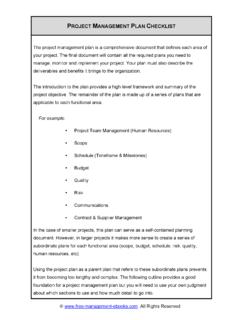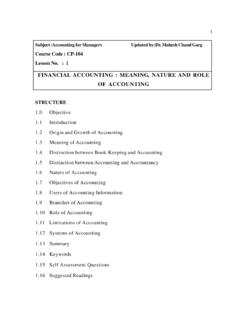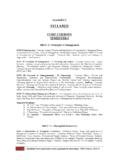Transcription of Cash Flow Analysis - Free Management eBooks
1 Cash Flow Analysis financial Skills Team FME. ISBN 978-1-62620-956-5. Copyright Notice 2013. All Rights Reserved ISBN 978-1-62620-956-5. The material contained within this electronic publication is protected under International and Federal Copyright Laws and treaties, and as such any unauthorized reprint or use of this material is strictly prohibited. You may not copy, forward, or transfer this publication or any part of it, whether in elec- tronic or printed form, to another person, or entity. Reproduction or translation of any part of this work without the permission of the copy- right holder is against the law. Your downloading and use of this eBook requires, and is an indication of, your complete acceptance of these Terms of Use.
2 '. You do not have any right to resell or give away part, or the whole, of this eBook. Cash Flow Analysis Table of Contents Preface 2. Visit Our Website 3. Introduction 4. Importance of Managing Working Capital 6. Debtors 7. Inventory/Stock 8. Creditors 9. Cash 10. How is Cash Flow Defined? 13. A Cash Flow Forecast 14. A Cash Flow Statement 15. Understanding the Changes in Cash 18. A Direct Format Cash Flow Statement 20. An Indirect Format Cash Flow Statement 21. Adjustments 24. Cash for Investing 30. Cash from Financing 32. Net Cash Flow 32. Supplemental Information 33. Summary 34. Other Free Resources 36. References 36. ISBN 978-1-62620-956-5 1. Cash Flow Analysis Preface This eBook will help you to understand how cash flows are generated and what factors affect them.
3 This knowledge is an integral part of making financial decisions that in- crease a firm's economic value or the capabilities of a nonprofit organization. You will learn How working capital is generated and why it needs to be actively managed The purpose of a cash flow statement and how it complements the other key finan- cial reports The counter-intuitive way that the cash account' is used in published accounts How to analyze an indirect format cash flow statement to see the true financial status of an organization How to compare accounts that have been prepared using different accounting methods ISBN 978-1-62620-956-5 2. Cash Flow Analysis Visit Our Website More free Management eBooks along with a series of essential templates and check- lists for managers are all available to download free of charge to your computer, iPad, or Amazon Kindle.
4 We are adding new titles every month, so don't forget to check our website regularly for the latest releases. Visit ISBN 978-1-62620-956-5 3. Cash Flow Analysis Introduction Cash flow is simply the flow of cash through the organization over time. In the case of businesses that are run for profit, cash is paid out in return for the labor and materials that are used to provide goods and services that can be sold. The revenues received provide cash that can then be used to finance further production and sales as well as increasing the organization's economic value. Cash flows are also essential for nonprofit organizations such as charities, schools, and hospitals that need to meet the various ongoing expenses associated with providing their services.
5 As a manager, you need to understand how cash flows are generated and what factors impact those flows . This knowledge is an integral part of making financial decisions that increase a firm's economic value or the capabilities of a nonprofit organization. The Management of cash flow is one part of a larger Management responsibility known as the Management of working capital, which refers to the operating liquidity available to an organization. is the LIQUIDITY. Working Operating requires assets Liquidity to be readily Capital available to an convertible to organization cash An organization can have assets and profitability, but find itself short of liquidity if its as- sets cannot readily be converted into cash.
6 Working capital is required to ensure that the organization is able to continue its opera- tions and that it has sufficient funds to satisfy operational expenses and any maturing short-term debt. The Management of working capital involves managing the four follow- ing aspects of an organization's operations: Inventories (stock, work-in-progress and finished goods). Accounts receivable (debts that are owed to the organization). Accounts payable (money the organization owes to its suppliers). Cash ISBN 978-1-62620-956-5 4. Cash Flow Analysis Effective Management of working capital will increase the profitability of the organiza- tion. It also enables managers to concentrate on their jobs without worrying too much about the potential for insolvency.
7 Effective Management of Working Capital is essential For Commercial For Nonprofit Organizations Organizations it can reduce the amount of it increases profitability capital required It can also reduce the amount of capital needed to run the enterprise, so even if you work in the nonprofit sector it is still an important consideration. Key Points 44 Cash flow is simply the flow of cash through the organization over time. 44 Working capital is required to ensure that the organization is able to continue its day-to-day operations. 44 The Management of working capital involves actively controlling inventories, accounts receivable, accounts payable, and cash. 44 The effective Management of working capital can increase profitability in the private sector and reduce the amount of capital required by nonprofit orga- nizations.
8 ISBN 978-1-62620-956-5 5. Cash Flow Analysis Importance of Managing Working Capital Many organizations that fail are profitable at the time, and their demise often comes as a surprise to managers and staff who can see that there is a full order book and plenty of satisfied customers. In these circumstances, the reason for the failure is usually down to a shortage of working capital. Many organizations fail because of a shortage of working capital This shortage in working capital can cause a company to not be able to pay its workers or suppliers even though there are sufficient sales and profits. Even in cases where these short-term liabilities can be met, the deterioration of cash flow critically undermines a company's ability to reinvest in the business and, ultimately, to survive.
9 The four factors that affect the amount of working capital available within an organiza- tion are: Accounts Inventories Receivable (Debtors). Accounts Payable Cash (Creditors). ISBN 978-1-62620-956-5 6. Cash Flow Analysis The Management role that you perform may only influence one of these areas directly, but having a clear understanding of them all will give you an insight into how well your orga- nization controls its working capital, and by extension how well it is managed financially. Debtors These are entities that owe your organization money. Many organizations have problems caused by the slow payment of invoices and this in turn affects working capital and, in particular, liquidity.
10 Chasing up unpaid invoices can be very time consuming and there is a fine line between maintaining a good working relationship with your customers and upsetting them by demanding payment too aggressively. Whatever your organization's policy is in the area of debt collection you will need to set expectations appropriately with customers and be polite but assertive in following through with requests for payment. This is a key area you need to monitor closely to ensure problem payers are identified as soon as possible. NOTE: goods WAYS TO Focus on largest or service have MINIMIZE DEBT debts first been received Agree payment Ask for payment Give high priority terms in advance early & often to credit control Prompt sending Have Resolve queries out of invoices comprehensive quickly etc.

















